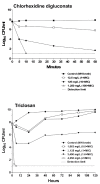High-level tolerance to triclosan may play a role in Pseudomonas aeruginosa antibiotic resistance in immunocompromised hosts: evidence from outbreak investigation
- PMID: 22260715
- PMCID: PMC3292827
- DOI: 10.1186/1756-0500-5-43
High-level tolerance to triclosan may play a role in Pseudomonas aeruginosa antibiotic resistance in immunocompromised hosts: evidence from outbreak investigation
Abstract
Background and methods: Pseudomonas aeruginosa is a major infectious threat to immunocompromised patients. We recently reported a fatal epidemic of multidrug-resistant P. aeruginosa in an onchoematology unit, linked to massive contamination of a triclosan-based disinfectant. The aim of this study is to evaluate the antimicrobial activity of triclosan and chlorhexidine digluconate against the epidemic strain of P. aeruginosa, to confirm the hypothesis that the soap dispenser acted as a continuous source of the infection during the outbreak, and to explore the potential role of triclosan in increasing the level of resistance to selected antibiotics.Susceptibility tests and time-kill assays for disinfectans were performed using two commercial formulations containing triclosan and chlorhexidine digluconate, respectively. Antibiotic susceptibility testing was performed by the broth microdilution method.
Findings: The P. aeruginosa epidemic strain exhibited an extremely high level of triclosan resistance (apparent MIC = 2,125 mg/L), while it was markedly susceptible to chlorhexidine digluconate (apparent MIC = 12.5 mg/L). Upon gradual adaptation to triclosan, the epidemic strain survived for a long period (> 120 h) in the presence of 3,400 mg/L (equivalent to 1.6 × MIC) of triclosan, concomitantly increasing the resistance to six antibiotics that are typical substrates of drug efflux pumps of the resistance nodulation division family. This effect was reversed by efflux pump inhibitors.
Conclusions: The epidemic P. aeruginosa strain was resistant to triclosan and its previous exposure to triclosan increases antibiotic resistance, likely through active efflux mechanisms. Since P. aeruginosa can become tolerant to elevated triclosan concentrations, the use of triclosan-based disinfectants should be avoided in those healthcare settings hosting patients at high risk for P. aeruginosa infection.
Figures
Similar articles
-
Molecular epidemiology of a Pseudomonas aeruginosa hospital outbreak driven by a contaminated disinfectant-soap dispenser.PLoS One. 2011 Feb 16;6(2):e17064. doi: 10.1371/journal.pone.0017064. PLoS One. 2011. PMID: 21359222 Free PMC article.
-
Prevalence of resistance genes to biocides in antibiotic-resistant Pseudomonas aeruginosa clinical isolates.Mol Biol Rep. 2022 Mar;49(3):2149-2155. doi: 10.1007/s11033-021-07032-2. Epub 2021 Dec 1. Mol Biol Rep. 2022. PMID: 34854015
-
Development of an accumulation assay and evaluation of the effects of efflux pump inhibitors on the retention of chlorhexidine digluconate in Pseudomonas aeruginosa and Staphylococcus aureus.BMC Res Notes. 2017 Jul 26;10(1):328. doi: 10.1186/s13104-017-2637-2. BMC Res Notes. 2017. PMID: 28747232 Free PMC article.
-
Pseudomonas aeruginosa chromosomal beta-lactamase in patients with cystic fibrosis and chronic lung infection. Mechanism of antibiotic resistance and target of the humoral immune response.APMIS Suppl. 2003;(116):1-47. APMIS Suppl. 2003. PMID: 14692154 Review.
-
Active efflux, a common mechanism for biocide and antibiotic resistance.Symp Ser Soc Appl Microbiol. 2002;(31):65S-71S. Symp Ser Soc Appl Microbiol. 2002. PMID: 12481830 Review.
Cited by
-
Reduced Susceptibility and Increased Resistance of Bacteria against Disinfectants: A Systematic Review.Microorganisms. 2021 Dec 10;9(12):2550. doi: 10.3390/microorganisms9122550. Microorganisms. 2021. PMID: 34946151 Free PMC article. Review.
-
Influence of light-curing mode on the erosion preventive effect of three different resin-based surface sealants.Int J Dent. 2012;2012:874359. doi: 10.1155/2012/874359. Epub 2012 Sep 6. Int J Dent. 2012. PMID: 22991513 Free PMC article.
-
Draft Genome Sequence of Triclosan-Resistant Cystic Fibrosis Isolate Achromobacter xylosoxidans CF304.Genome Announc. 2015 Jul 30;3(4):e00865-15. doi: 10.1128/genomeA.00865-15. Genome Announc. 2015. PMID: 26227609 Free PMC article.
-
Use of monofilament sutures and triclosan coating to protect against surgical site infections in spinal surgery: a laboratory-based study.Eur J Orthop Surg Traumatol. 2023 Oct;33(7):3051-3058. doi: 10.1007/s00590-023-03534-w. Epub 2023 Mar 31. Eur J Orthop Surg Traumatol. 2023. PMID: 37000241 Free PMC article.
-
Study of Combined Effect of Bacteriophage vB3530 and Chlorhexidine on the Inactivation of Pseudomonas aeruginosa.BMC Microbiol. 2023 Sep 13;23(1):256. doi: 10.1186/s12866-023-02976-w. BMC Microbiol. 2023. PMID: 37704976 Free PMC article.
References
-
- Poole K. Multidrug efflux pumps and antimicrobial resistance in Pseudomonas aeruginos and related organisms. J Mol Microbiol Biotechnol. 2001;3:255–264. - PubMed
LinkOut - more resources
Full Text Sources
Other Literature Sources
Medical


